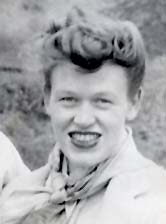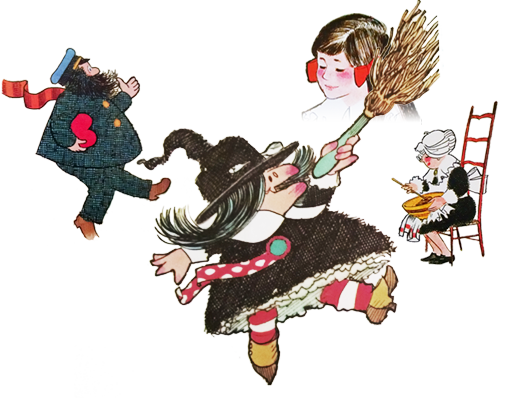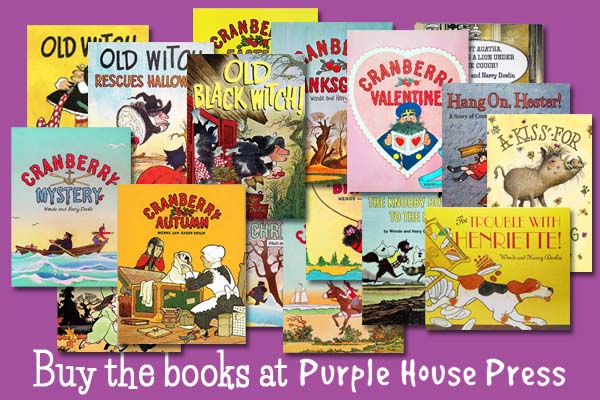
Wende Devlin, c.1941
Dorothy Wende was born on April 27, 1918 in Buffalo, New York to Dr. Bernhardt Phillip Wende and Elizabeth May Buffington. She was known to her family and friends as “Wende”.
Wende was a frequent visitor to the Albright-Knox Art Gallery and took private art lessons as a child. She became the art editor of the yearbook. Wende met Harry at the Crouse College of Art in Syracuse in 1938 and went on to receive her BFA in 1940.
Harry graduated a year before Wende and his promising career took off. After being hired by Life Magazine to prepare Army manuals, along with other freelance work, Harry felt financially secure enough to propose to Wende. They were married on August 30, 1941.
 The couple initially settled in Manhattan, but soon left the bustling city for a quiet thatched-roof home in the tiny town of Valley Cottage, NY, in Rockland County. There they developed friendships with well-known writers, artists, singers and painters such as Maxwell Anderson and Lotte Lenya. Their idyllic lifestyle was shattered by the entry of the United States into World War II. On October 30, 1942 as Harry prepared for his first day of military service, Wende gave birth to the first of the couple’s seven children, Harry Noel (later known as “Herke”).
The couple initially settled in Manhattan, but soon left the bustling city for a quiet thatched-roof home in the tiny town of Valley Cottage, NY, in Rockland County. There they developed friendships with well-known writers, artists, singers and painters such as Maxwell Anderson and Lotte Lenya. Their idyllic lifestyle was shattered by the entry of the United States into World War II. On October 30, 1942 as Harry prepared for his first day of military service, Wende gave birth to the first of the couple’s seven children, Harry Noel (later known as “Herke”).
Between feedings and diaper changes, Wende continued to paint extraordinary portraits and still lifes. In 1946, first daughter Wende Elizabeth arrived. The growing Devlin family relocated to Elizabeth, NJ. Harry went through a prosperous time with steady employment as the lead editorial cartoonist at Collier’s, numerous freelance assignments including Saturday Home Magazine and the book, Innocents at Home. The Devlins summered on Cape Cod with their children, now numbering four with the addition of Jeffrey Anthony and Alexandra Gail.

The Devlin Family with their pet donkey, Eliza Doolittle, c. 1959
In 1950, the family moved to a magical, three acre hilltop property in Mountainside, NJ with a large Victorian farmhouse and a carriage house they converted into an artist’s studio. Harry and Wende collaborated on a cartoon strip called “Fullhouse” and later called “Raggmopp” based on the fun and chaos of their growing family.
The Golden Age of Illustration came to an end and in 1956, Wende started a humorous column for Good Housekeeping magazine using elegant lyricism and comedy to describe domestic ironies. She managed to find time to write two new comic strips – “Amy” and “Margie” while raising her seven young children.
 In 1963, Wende and Harry combined their unique talents to produce their first children’s book, Old Black Witch! Wende wrote the book and Harry illustrated. This led to other “Old Witch” books and in 1971, they started a new series with the publication of Cranberry Thanksgiving.
In 1963, Wende and Harry combined their unique talents to produce their first children’s book, Old Black Witch! Wende wrote the book and Harry illustrated. This led to other “Old Witch” books and in 1971, they started a new series with the publication of Cranberry Thanksgiving.
Other books written by Wende include: Old Black Witch, 1963, Old Witch and the Polkadot Ribbon, 1963, The Knobby Boys to the Rescue, 1965, Aunt Agatha, There is a Lion Under the Couch, 1968, How Fletcher was Hatched, 1970 (N.J. English Teachers Award), A Kiss for a Warthog, 1970, Cranberry Thanksgiving, 1971, Old Witch Rescues Halloween, 1973, (Chicago Book Fair Award for excellence 1974), Cranberry Christmas, 1973, Cranberry Mystery, 1979, Hang on Hester 1980, Cranberry Valentine, 1986, Cranberry Summer, 1991, Cranberry Autumn, 1994, The Trouble with Henriett, 1995. Wende also created a comic strip Ragg Mopp, which ran from 1954-57, and contributed many poems to Good Housekeeping Magazine.

Wende at her easel with her portrait of Alexandra Devlin, c.1963
Wende’s work is represented with a permanent collection at Midlantic Bank of N.J., National Westminister Bank of N.J., as well as in many private collections. She had a one person show at Schering Plough, N.J. She was awarded the Arents Medal for Art and Literature, the highest alumni award, from Syracuse University in 1977. She was a member of Rutgers Advisory Council on Children’s Literature since 1980 and was named to the N.J. Literary Hall of Fame in 1989.
Wende’s gifted words will continue to enthrall future generations as they get tucked under the covers and fall asleep listening to her delightful stories, just as her own children probably did when she first spun these tales. Her timeless words, brought alive by Harry’s vivid illustrations, leave a amazing testimony to the talents of Wende Devlin.

Wende Devlin, “Portrait of Gurli Benou”, c.1985
See also: Harry Devlin


